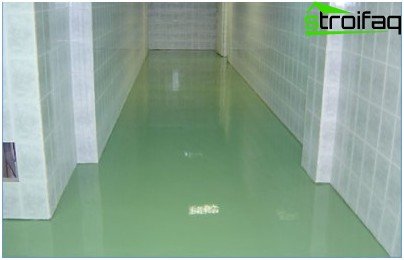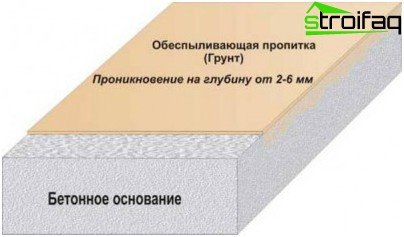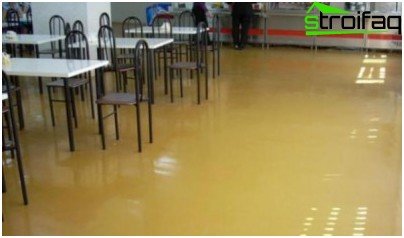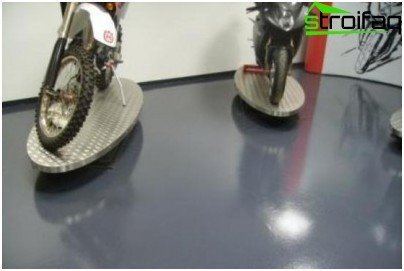Dusting concrete floor
Dust formation is one of the few negative factors accompanying the operation of rooms with concrete floors. From the intense impact of the load, the structural bonds of the top layer of the concrete coating are broken. Because of this, the artificially created stone floor begins to collapse, spreading dust. Harmful suspension clogs electronics, machines with complex software control. It settles on clothes, furniture, manufactured products and in the respiratory organs of people in the room. Dust removal of a concrete floor will help to prevent unwanted spread of dusty suspension, as a result of which several important tasks are simultaneously solved.
Content
- Concrete dedusting technology
- Dust removal impregnation types
- Standard work steps
The essence of the process of dust removal of concrete is the processing of special penetrating compounds. Due to this, not only the spread of dusty suspension harmful to people and equipment is stopped, but also the strength characteristics of the material increase. Measures to protect against dust prevent premature abrasion of the upper layer of the concrete floor, exclude the appearance of microcracks and other defects.

Dust removal of concrete floors is carried out in order to increase technical characteristics, ensure ideal hygienic conditions and extend the life of the
Concrete dedusting technology
Penetrating deep into the porous structure of artificially created stone, special impregnations interact with the components of concrete. The resulting filamentary insoluble crystals block the starting processes of destruction and fix finely dispersed particles that do not have strong structural bonds.
At the same time, microscopic cracks that have already appeared, which are intensively absorbing water and chemical reagents, fill up capillaries, voids, and pores. That is, the surface of the concrete floor acquires the ability to resist, both mechanical and chemical, biological, moisture exposure. In addition, the concrete floor treated with dedusting impregnations begins to hold heat shocks steadily and does not react at all to sharp and frequent temperature fluctuations..
As a result of the treatment of concrete floors with dedusting compounds:
- resistance to aggressive effects of factors of chemical and biological origin is formed;
- resistance to abrasive substances is provided;
- water-repellent properties increase;
- concrete floor life is extended;
- dust distribution is eliminated;
- increases the aesthetic component;
- care processes are facilitated.

The principle of dust removal
Processing the floor with special impregnations designed to protect against dust and strengthen the structure of concrete will “delay” the need for repair or replacement of worn coatings for a long time, and will provide the conditions required by operating standards.
Dust removal impregnation types
To improve the technical characteristics, wear resistance and decorative indicators of concrete floors, two varieties of impregnating compositions are used, these are:
- Impregnations created on an organic basis, which include acrylic, polyurethane, epoxy materials. With their help, pores, microcracks, capillary channels are filled with chains of molecules of organic origin.
- Fluates – impregnating materials having an inorganic base. Protective and reinforcing treatment of concrete with fluids is carried out by converting a soluble substance into an insoluble compound containing silica (silicon dioxide SiO2). The most stable glassy compound of silicon with oxygen increases the strength and density of the concrete floor, prevents the penetration of aggressive chemical components.
Now manufacturers offer impregnations suitable for processing floors made of any brand of concrete. The appropriate composition can be selected for a highly cracked worn surface and for a newly laid new mosaic floor. Processing and restoration of the technical characteristics of concrete floors can be performed under any temperature conditions in any premises.

You can dust the concrete floor at any time, in any premises
Standard work steps
Depending on the degree of attrition and destruction of concrete, as well as the goals pursued by the owner of the premises, the number of stages of dust removal is determined.
It is not necessary to carry out part of the measures if a new floor is being processed or the esthetic criteria are not important to the owner. Basically, the full cycle of work includes:
- polishing the surface, by means of which the upper brittle layer of the worn concrete floor or cement milk of the coating laid two or three weeks ago is removed;
- repair of defects, potholes, cracks and expansion joints is carried out using epoxy primers and repair mixtures with an organic base, thereby preventing further increase in defects in the destroyed areas;
- dust is cleaned using specialized equipment that perfectly collects all dust and sludge formed during the grinding and repair of concrete floors;
- application of impregnating compositions that strengthen concrete, level the floor surface, creating protection against unwanted penetration into the pores of water, chemicals, impurities;
- priming with polymeric materials, if necessary, to strengthen the floor made of concrete with weak bearing capacity, and also with a significant amount of damage;
- coloring of industrial floors, if it was intended as a decorative coating, for which epoxy and polymer dyes are used;
- varnishing of mosaic concrete floors with granite or marble chips, realized by applying protective and decorative polymer varnishes.

Dusty and painted durable cement floor
In order to reduce sliding friction of varnished or painted concrete floors, well-sifted fine-grained quartz sand is often applied to a dust-free coating..
Dust removal of concrete floors helps to restore the performance of a worn surface, protect the new floor from premature destruction. In any case, dusting and strengthening is much cheaper than repairing serious damage or equipping the room with a new floor covering..






